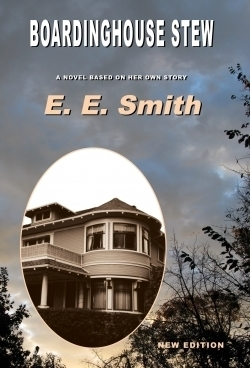Boardinghouse Stew
Things were different back then. There was a war on, and everyone in the US was deeply involved, from rationing daily foodstuffs to—if you were Japanese—being forcefully uprooted from your home to a filthy “relocation center,” where you and your family could be safely surveilled.
During the summer of 1943, eleven-year-old narrator Eileen Smith does her part for the war effort: cleaning, cooking, and gardening at Mrs. Mumson’s deteriorating guest house. In the tradition of Capote and O’Neill, Boardinghouse Stew is Eileen’s nonfiction novel, originally released in the 1980s as a headline-grabbing stage play of the same name.
Set in Sacramento, Boardinghouse Stew is a fast-paced comedic and dramatic frolic, examining the lives of seven divergent personalities and their highly individualized responses to the war and each other.
Widower Mrs. Mumson refuses to call her boardinghouse a “boardinghouse;” instead insisting that this “guest house” is a rest stop on the way to future success for cannery man Howard, med student and most eligible bachelor Doc, handsome mystery man Teddy, soldier wanna-be Iris, hipster supermodel Patsy, and wallflower Margaret. Little Eileen substitutes for the recently departed Yukie, a Japanese houseboy hauled away to one of California’s concentration camps.
So what was so different in the Good Old Days? As Eileen innocently narrates, the men were gentlemen, except for Howard, who gets Margaret pregnant; love was natural, except for Doc and Patsy’s clumsy attempts to even converse (without breaking a vase or falling down the stairs); women were proper ladies, except for Iris, who’s more prepared for combat than Patton; and the heroes always wore white, except for sports-car Teddy, who may spy for the FBI or break legs in the Sacramento Mob.
Eileen loses some of her innocence by eavesdropping at the rusty hinges of the dining room door. She hears too much, all the time. And that’s a blessing because, as a child, Eileen truly wants the best for these strangers who become her friends—even if she does feed them too many prunes in the recipes she trusts from the city newspaper’s wartime culinary expert, “Miss Kitchen.”
Smith slyly passes along a 1940s version of the truth in this stunning nostalgic debut. The boarders’ actions challenge the myths of the American Dream that have always made it a hard-won destination and, after all, a funny, sad, beautiful, and horrible reality. All of these characters have to “grow up.” And they do (except for old Mrs. Mumson, who continues talking to a wall portrait of her dead husband).
Boardinghouse Stew is unpredictable, hearty, and satisfying, much like Eileen’s prune-laced bowls of stew.
Reviewed by
Brandon Stickney
Disclosure: This article is not an endorsement, but a review. The publisher of this book provided free copies of the book and paid a small fee to have their book reviewed by a professional reviewer. Foreword Reviews and Clarion Reviews make no guarantee that the publisher will receive a positive review. Foreword Magazine, Inc. is disclosing this in accordance with the Federal Trade Commission’s 16 CFR, Part 255.

